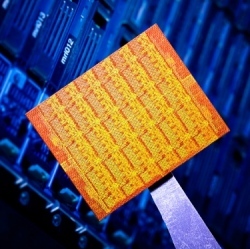
Sun Microsystems cofounder and networking guru Andy Bechtholsheim predicted that networking chips — which determine how quickly you can surf the Internet — will keep following the path of progress that it has for decades. Moore’s Law, the prediction in 1965 by Intel’s Gordon Moore that the number of transistors on a chip will double every two years, is still holding up.
In the next 20 years, Bechtolsheim expects an improvement of 1,000 times in chip performance. We should all greet that with relief, since the $1 trillion-plus electronics economy depends on the continuous efficiencies gained from making chips smaller, faster, and cheaper.
“We are in the Golden Age of networking, driven by Moore’s Law,” said Bechtolsheim in a keynote speech at the Linley Tech Processor conference in San Jose, Calif.
Bechtolsheim is worth listening to. He is the founder, chairman, and chief development officer at networking hardware firm Arista Networks, which builds cloud-based appliances for large data centers. He was the chief system architect at Sun and became famous as the angel who funded Google.
He also started Granite Systems, which Cisco acquired in 1996. He developed a series of switches at Cisco and also founded Kealia, which Sun acquired in 2004.
Bechtolsheim talked a lot about leaf switches and buffers and spines and other stuff that was way over my head. But he closed his talk with a series of predictions about the future of Moore’s Law and its relevance to the future of networking, which depends on data centers with tons of servers, each with lots of chips, powered by multiple computing brains (or cores). In data centers, keeping the flow of data moving as fast as possible between the outside world, through memory, into processors and into long-term storage is of paramount concern. It’s a realm in which nanoseconds matter.
Today’s networking chips transfer data at rates of 10 gigabits a second, 40 gigabits a second, or 100 gigabits a second. Part of that depends on chips, but it also depends on optical components that transfer data using laser components, which are harder to improve compared to silicon chip technology.
(Read original Article)…
